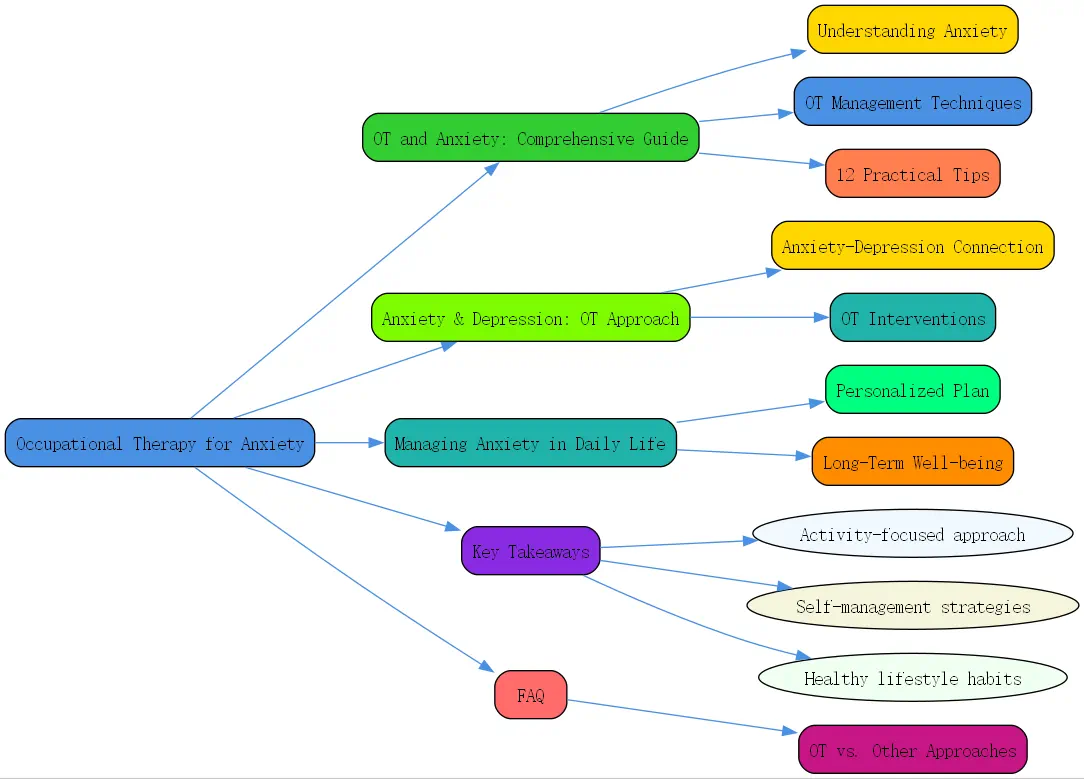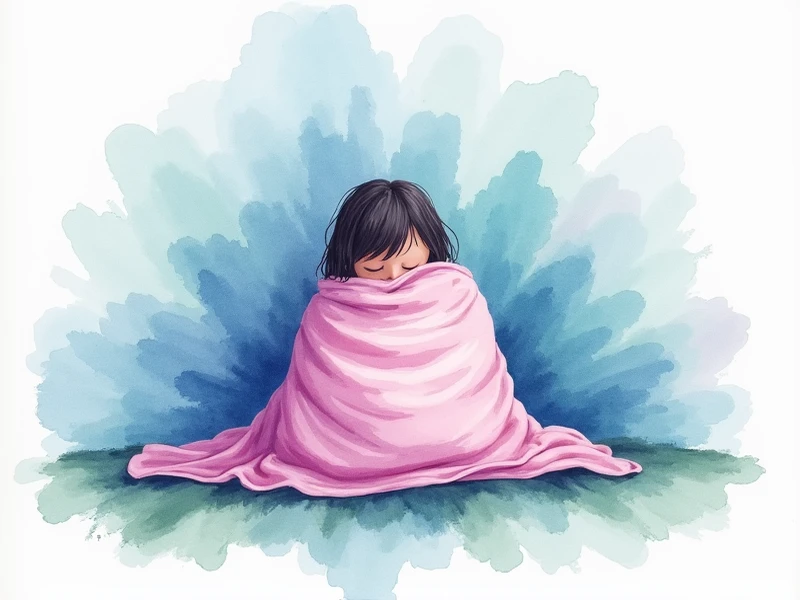Occupational Therapy and Anxiety Management: A Comprehensive Guide

Anxiety disorders affect millions worldwide, disrupting daily functioning and diminishing quality of life. In recent years, occupational therapy has emerged as a powerful approach for managing anxiety symptoms. At BrainTalking, we understand the complex relationship between daily activities and mental health, which is why we’ve created this comprehensive guide to occupational therapy and anxiety management techniques.
Understanding Anxiety Disorders
What is Generalized Anxiety Disorder (GAD)?
Generalized Anxiety Disorder is a prevalent mental health condition characterized by persistent and excessive worry about various aspects of life, often without a specific trigger. Unlike occasional anxiety that everyone experiences, GAD involves chronic feelings of apprehension, tension, and unease that can significantly disrupt daily functioning. This condition typically develops gradually and may persist for months or years if left untreated.
Symptoms and Impact on Daily Life
The symptoms of GAD extend beyond mental distress to include physical manifestations such as restlessness, irritability, muscle tension, difficulty concentrating, fatigue, and sleep disturbances. These symptoms can create a vicious cycle, where anxiety about one area of life spills over into others, causing impairment in social, occupational, and academic areas.
People with GAD often report feeling constantly “”on edge,”” having trouble relaxing, and experiencing disruptions in their ability to perform everyday tasks. Simple activities like grocery shopping or attending social gatherings can become overwhelming challenges, leading to avoidance behaviors that further restrict life participation.
The Role of Occupational Therapy in Anxiety Management
Occupational therapy offers a unique perspective on anxiety management by focusing on how anxiety affects participation in meaningful daily activities or “”occupations.”” Unlike approaches that focus solely on symptom reduction, occupational therapy addresses the whole person and their environment.
Occupational therapists work collaboratively with clients to identify how anxiety impacts their daily routines, relationships, and ability to engage in valued activities. They then develop personalized strategies to help clients overcome barriers to participation while simultaneously addressing underlying anxiety symptoms.
This holistic approach makes occupational therapy particularly effective for anxiety management, as it addresses both the psychological aspects of anxiety and their real-world implications.
Occupational Therapy Anxiety Management Techniques
Sensory Integration Techniques
Sensory integration is a cornerstone of occupational therapy anxiety management techniques. This approach recognizes that many individuals with anxiety have sensory processing differences that can either trigger or exacerbate anxiety symptoms.

Occupational therapists may introduce weighted blankets, compression garments, or specific sensory activities to help regulate the nervous system. These interventions can provide calming proprioceptive input that helps reduce physiological arousal associated with anxiety.
For example, a therapist might create a personalized “”sensory diet”” that includes activities like deep pressure massage, rhythmic movement, or specific tactile experiences that promote relaxation and emotional regulation.
Cognitive Behavioral Therapy (CBT) in Occupational Therapy
While CBT is often associated with psychology, occupational therapists incorporate these evidence-based techniques into their practice with a unique activity-focused approach. Occupational therapists help clients identify how anxious thoughts affect their ability to engage in daily activities and then develop strategies to challenge and reframe these thoughts.
For instance, an occupational therapist might work with a client who avoids social gatherings due to anxiety by gradually exposing them to social situations while providing tools to manage anxious thoughts. This might include role-playing social interactions, practicing relaxation techniques before events, and creating coping cards with alternative thought patterns.
Mindfulness and Relaxation Strategies
Occupational therapists teach clients mindfulness and relaxation techniques that can be integrated into daily routines. These practices help individuals become more aware of their thoughts and physical sensations without judgment, creating space between triggering events and anxious responses.
Techniques might include guided meditation, body scanning, progressive muscle relaxation, or mindful engagement in everyday activities like cooking or gardening. By incorporating these practices into daily routines, clients develop sustainable anxiety management skills that support long-term well-being.

12 Practical Tips to Manage Anxiety and Stress
Seek Professional Help for Anxiety and Depression Management
Consulting a mental health professional, such as an occupational therapist, psychologist, or psychiatrist, is crucial for effective anxiety and depression management. These professionals can provide an accurate diagnosis and develop a personalized treatment plan tailored to your specific needs and circumstances.
Occupational therapy, in particular, offers a practical approach to managing anxiety by focusing on how it affects your daily activities and developing strategies to improve function in these areas. Don’t hesitate to reach out for professional support鈥攊t’s a sign of strength, not weakness.
Practice Relaxation Techniques and Mindfulness Meditation
Learning and regularly practicing relaxation techniques is one of the most effective tips to manage anxiety and stress. Deep breathing exercises, progressive muscle relaxation, and mindfulness meditation can help calm your mind and body, reducing anxiety symptoms.
Try setting aside 10-15 minutes daily for these practices. For example, practice deep breathing by inhaling slowly through your nose for a count of four, holding for a count of two, and exhaling through your mouth for a count of six. Consistent practice enhances these techniques’ effectiveness over time.
Engage in Regular Exercise and Maintain a Healthy Lifestyle
Regular physical activity is a powerful anxiety management tool that releases tension, produces endorphins, and improves overall mood. Aim for at least 30 minutes of moderate exercise most days of the week, choosing activities you enjoy such as walking, jogging, swimming, or yoga.
Additionally, maintaining a healthy lifestyle by prioritizing adequate sleep, balanced nutrition, and limiting caffeine and alcohol intake can significantly impact your ability to manage anxiety. A well-nourished body and sufficient rest better equip you to handle stress and anxiety triggers.
Establishing Healthy Habits for Anxiety Relief
Challenge Negative Thoughts and Practice Reframing
Negative thought patterns often fuel anxiety. Learning to identify, challenge, and reframe these thoughts is a valuable skill for long-term anxiety management. When you notice anxious thoughts arising, pause and ask yourself: “”Is this thought based on facts or assumptions?”” and “”What would I tell a friend who had this thought?””
Practice replacing catastrophic thinking with more balanced perspectives. For example, instead of thinking, “”This presentation will be a complete disaster,”” try, “”This presentation may be challenging, but I’ve prepared well and can handle it.””
Establish a Daily Routine for Structure and Stability
Creating and maintaining a consistent daily routine provides structure and predictability, which can be particularly comforting for individuals with anxiety disorders. Regular schedules for sleep, meals, work, and leisure activities help reduce the uncertainty that often triggers anxiety.
Start by establishing consistent wake-up and bedtime routines, then gradually build structure around other daily activities. Remember that routines should be flexible enough to accommodate life’s inevitable changes while providing a stable framework for daily functioning.
Set Realistic Goals and Celebrate Small Achievements
Breaking larger tasks into smaller, manageable steps prevents overwhelming feelings that can trigger anxiety. Set specific, achievable goals and acknowledge your progress, no matter how small.
For example, if job searching triggers anxiety, break it down into steps like updating your resume, researching companies, and applying to one position per day. Celebrate each completed step to build confidence and momentum. This approach, often used in occupational therapy and anxiety management programs, builds self-efficacy over time.
The Importance of Social Connection and Self-Compassion
Stay Connected: Building a Support Network
Maintaining social connections is vital for mental health and anxiety management. Regular interaction with supportive friends, family members, or support groups provides validation, perspective, and emotional relief.
Be intentional about nurturing relationships that make you feel understood and accepted. This might involve scheduling regular coffee dates with friends, joining community groups aligned with your interests, or participating in support groups specifically for anxiety. Remember that quality connections matter more than quantity.
Consider Medication as a Management Option
For some individuals, medication may be an important component of anxiety management, especially when therapy alone doesn’t provide sufficient relief. Medications such as selective serotonin reuptake inhibitors (SSRIs) or benzodiazepines can help manage symptoms while you develop long-term coping strategies.
If you’re considering medication, consult with a healthcare provider about potential benefits and risks, expected timelines for effectiveness, and possible side effects. Medication works best when combined with therapy and lifestyle changes rather than as a standalone treatment.
Practice Self-Compassion and Kindness
Self-compassion鈥攖reating yourself with the same kindness and understanding you would offer a good friend鈥攊s essential for anxiety management. Many people with anxiety are harshly self-critical, which only intensifies their symptoms.
Practice speaking to yourself with gentleness, especially during difficult moments. Acknowledge that managing anxiety is challenging and that setbacks are normal parts of the healing journey. Remember that self-compassion isn’t self-indulgence鈥攊t’s a scientifically validated approach to improving mental health.
Anxiety and Depression Management: The Occupational Therapy Approach
The Connection Between Anxiety and Depression
Comorbidity of Anxiety and Depression
Anxiety and depression frequently co-occur, with studies suggesting that up to 60% of people with anxiety also experience depression at some point. These conditions share common risk factors and can exacerbate each other, creating a complex clinical picture that requires comprehensive treatment.
When anxiety and depression coexist, symptoms often include persistent worry, fatigue, sleep disturbances, difficulty concentrating, and loss of interest in previously enjoyable activities. This combination can significantly impact daily functioning and quality of life, making effective management strategies crucial.
How Occupational Therapy Addresses Both
Occupational therapy offers a unique advantage in addressing comorbid anxiety and depression by focusing on meaningful activity engagement. Rather than treating symptoms in isolation, occupational therapists help clients identify and overcome barriers to participation in valued life activities.
This activity-focused approach naturally addresses both anxiety and depression by promoting engagement, building confidence through successful experiences, and creating opportunities for positive social interaction. By helping clients re-engage with meaningful activities, occupational therapists target the avoidance behaviors common in anxiety and the withdrawal patterns typical of depression.
Occupational Therapy Interventions for Anxiety and Depression
Activity Scheduling and Goal Setting
Occupational therapists work with clients to develop structured activity schedules that incorporate a balance of productive, leisure, and self-care activities. This approach combats the inactivity and avoidance that characterize both anxiety and depression.
Through collaborative goal setting, therapists help clients identify meaningful activities and break them into manageable steps. This process builds motivation, provides a sense of purpose, and creates opportunities for mastery experiences that boost confidence and mood.
Improving Sleep Hygiene
Sleep disturbances are common in both anxiety and depression, creating a vicious cycle that worsens symptoms. Occupational therapists help clients establish healthy sleep routines through environmental modifications, relaxation techniques, and activity pacing.
Interventions might include creating a calming bedtime routine, optimizing the sleep environment, limiting screen time before bed, and addressing anxious thoughts that interfere with sleep. These practical strategies improve sleep quality, which in turn enhances emotional regulation and cognitive function.
Enhancing Social Participation
Social withdrawal is common in both anxiety and depression, yet social connection is vital for recovery. Occupational therapists help clients gradually increase social engagement through structured activities that match their current capabilities and comfort levels.
This might involve practicing social skills in therapy, identifying low-pressure social opportunities, or using technology to maintain connections during difficult periods. By supporting social participation, occupational therapy addresses a key factor in both anxiety and depression recovery.
Implementing Tips to Manage Anxiety and Stress in Daily Life
Creating a Personalized Anxiety Management Plan
Identifying Triggers and Coping Mechanisms
Developing awareness of your personal anxiety triggers is essential for effective management. BrainTalking experts recommend keeping an anxiety journal to track situations, thoughts, and physical sensations that precede anxiety episodes. This practice helps identify patterns and specific triggers that might otherwise go unnoticed.
Once triggers are identified, work on developing personalized coping mechanisms for each. For example, if workplace meetings trigger anxiety, coping strategies might include preparing talking points in advance, practicing deep breathing before meetings, or scheduling brief breaks afterward to decompress.
Utilizing Time Management Strategies
Poor time management can exacerbate anxiety by creating unnecessary pressure and last-minute rushes. Occupational therapists often help clients develop time management systems that reduce stress while accommodating their unique needs and challenges.
Effective strategies include breaking large projects into smaller tasks with specific deadlines, using visual schedules or digital reminders, building buffer time into schedules to accommodate unexpected delays, and learning to prioritize tasks based on importance rather than urgency alone.
Maintaining Long-Term Well-being
Regular Exercise and Diet Considerations
Consistent physical activity is one of the most effective natural anxiety treatments available. Exercise reduces stress hormones, increases endorphins, improves sleep quality, and enhances overall resilience to stress. Find activities you genuinely enjoy to increase the likelihood of maintaining them long-term.
Dietary choices also significantly impact anxiety levels. Consider reducing caffeine, alcohol, and refined sugars, which can trigger or worsen anxiety symptoms. Instead, focus on a balanced diet rich in complex carbohydrates, omega-3 fatty acids, and antioxidants, which support brain health and mood regulation.
Seeking Ongoing Support and Therapy
Anxiety management is often not a one-time intervention but an ongoing process of growth and adaptation. Regular check-ins with healthcare providers, continued therapy sessions as needed, and participation in support groups can provide the sustained support necessary for long-term well-being.
Remember that seeking help isn’t a sign of weakness but a proactive step toward health. Many people benefit from periodic “”booster”” therapy sessions even after their symptoms have improved, particularly during times of transition or increased stress.
Key Takeaways for Effective Anxiety Management
- Occupational therapy offers a unique, activity-focused approach to anxiety management that addresses both symptoms and functional impacts
- Combining professional help with self-management strategies creates the most effective approach to anxiety
- Regular practice of relaxation techniques, physical activity, and healthy lifestyle habits forms the foundation of anxiety management
- Challenging negative thoughts, establishing routines, and setting realistic goals helps break the cycle of anxiety
- Self-compassion and social connection are essential components of long-term anxiety management
- A personalized approach that addresses your specific triggers and needs is most effective for sustainable improvement
FAQ: Common Questions About Occupational Therapy and Anxiety Management
How is occupational therapy different from other approaches to anxiety treatment?
Occupational therapy differs from other anxiety treatments by focusing on how anxiety affects your ability to participate in meaningful daily activities. While traditional therapy might focus primarily on thought patterns or emotions, occupational therapy addresses these aspects while simultaneously helping you develop practical strategies to function better in real-world situations.
Occupational therapists consider your unique environment, roles, and values when developing treatment plans. They might help you modify your home or workplace to reduce anxiety triggers, develop compensatory strategies for challenging tasks, or gradually reintroduce activities you’ve been avoiding due to anxiety.
This practical, function-focused approach complements other treatments like medication or talk therapy, creating a comprehensive strategy for managing anxiety that extends beyond symptom reduction to improved quality of life and participation.





